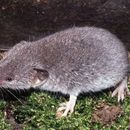en
names in breadcrumbs


The genus Crocidura is one of nine genera of the shrew subfamily Crocidurinae. Members of the genus are commonly called white-toothed shrews or musk shrews, although both also apply to all of the species in the subfamily. With over 180 species, Crocidura contains the most species of any mammal genus.[3] The name Crocidura means "woolly tail", because the tail of Crocidura species are covered in short hairs interspersed with longer ones.[4]
They are found throughout all tropical and temperate regions of the Old World, from South Africa north to Europe, and east throughout Asia, as far east as the Malay Archipelago. One species, the possibly extinct Christmas Island shrew (C. trichura), also inhabited Christmas Island. They likely originated in Africa or Asia Minor during the Miocene, spread to Europe by the early Pliocene, and spread to eastern Asia and the Mediterranean by the Pleistocene.[5][6]
*New species.[11][12][13][14][15]
A significant diversity of extinct Crocidura species is known from the early-mid Pleistocene of Morocco, but by the majority of these species went extinct between the Middle to Late Pleistocene boundary, and were replaced by modern species.[17] Indeterminate Crocidura remains are known from the Miocene-aged rocks in the Potwar Plateau of Pakistan, concurrent with fossils from the Shivalik Fossil Beds.[20]
Crocidura shrews were embalmed in Ancient Egypt, being associated with the dark aspect of the god Horus. Many of these mummies have been uncovered during excavations at the Falcon Necropolis, providing important information about the former diversity of shrews in this area.[16]
{{cite journal}}: CS1 maint: multiple names: authors list (link) The genus Crocidura is one of nine genera of the shrew subfamily Crocidurinae. Members of the genus are commonly called white-toothed shrews or musk shrews, although both also apply to all of the species in the subfamily. With over 180 species, Crocidura contains the most species of any mammal genus. The name Crocidura means "woolly tail", because the tail of Crocidura species are covered in short hairs interspersed with longer ones.
They are found throughout all tropical and temperate regions of the Old World, from South Africa north to Europe, and east throughout Asia, as far east as the Malay Archipelago. One species, the possibly extinct Christmas Island shrew (C. trichura), also inhabited Christmas Island. They likely originated in Africa or Asia Minor during the Miocene, spread to Europe by the early Pliocene, and spread to eastern Asia and the Mediterranean by the Pleistocene.